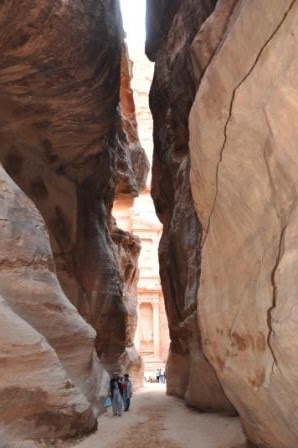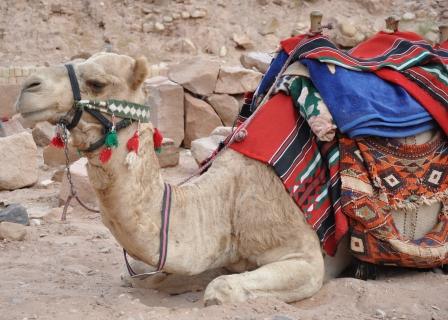We drove from Amman to Petra, a three hour drive, with Claire and Emerson. We arrived close to noon, checked into the Movenpick Hotel, and had a buffet lunch. We walked the 100 yards to the entrance to Petra and bought a two day pass. We began our journey into Petra...
The ruins of Petra are one of the most extraordinary archaeological complexes in the world. The Arabs called it "The Valley of Moses." The oldest known settlement at Petra dates to the Iron Age, or as early as 1200 BC. Petra's importance began from it's occupation by the Nabataeans during the 4th century BC. The Nabataeans were nomads from the Arabian peninsula, but once they became a settled people, they organized themselves into a solid monarchy with an economy based on trade. Starting in the 3rd century BC, Petra was turned into a rock city in a valley where several gullies meet. The location provided an easy journey to the Red Sea, the Mediterranean, and the ports of Syria. Trading brought about prosperity in Petra. The people began carving monuments from rock in the 1st century BC. The Romans annexed Petra in 106 AD under Trajan. For several centuries Petra continued to prosper, but after the Arab conquest of the region, it fell into decline. At the end of the 13th century, it was abandoned and forgotten about in the West until 1812, when it was rediscovered by Johann Bueckhardt, the famous Swiss traveler and orientalist.
We hiked into Petra through the slot canyon known as the Siq, 585' deep with walls as close as 12' apart in places. The hike in is over a mile long, with water channels carved into the rock the whole way. Nearing the end of the Siq, the most famous building of Petra appeared... the Treasury. It was built as a funerary temple and carved from the pink rock of the canyon. It's facade is 130' high and 81' wide. There were camels lounging in front of the Treasury when we arrived, adding to the ancient aura of Petra.
Just past the Treasury, the path widens with the Royal Tombs from the 1st century AD on either side, and coming to a 6000 seat theater dug out of sheer rock. The residential area of Petra, which housed over 20,000 residents in it's heyday, overlooks the theater and the vast mountains beyond, with cave dwellings dotting the landscape.
Emerson had ridden in a backpack on Papa's back and had had quite enough by the time we got this far. She played in the sand while we continued on the path. We came to a column lined avenue and a large stone gateway with two temples built of stone rather than carved into stone. One is being excavated by the Brown University Archaeology Department and the other has significant walls still standing. At this point on our first day, the sun was getting much lower in the sky and we headed back to our hotel. Emerson was having none of riding in the backpack, walking, being carried, or any form of transport out of the Siq except for riding on a horse. She and Claire hitched a ride to the exit.
The next morning Papa and I were up and eating breakfast by 6:30 and at the Petra entrance by 7. We power walked through the Siq, past the treasury, the tombs, and the colonnade, then made the mile plus climb, with an elevation change of 1140' to the Monastery. The Monastery dates to the 1st century AD and is the most impressive building in Petra, cut from the rock, with the facade 160' wide x 127' high. The view from the hill in front of the Monastery is of the vast valley below. Breathtaking!
Petra far exceeded our expectations. It deserves being on the list of Seven Wonders of the World!
The ruins of Petra are one of the most extraordinary archaeological complexes in the world. The Arabs called it "The Valley of Moses." The oldest known settlement at Petra dates to the Iron Age, or as early as 1200 BC. Petra's importance began from it's occupation by the Nabataeans during the 4th century BC. The Nabataeans were nomads from the Arabian peninsula, but once they became a settled people, they organized themselves into a solid monarchy with an economy based on trade. Starting in the 3rd century BC, Petra was turned into a rock city in a valley where several gullies meet. The location provided an easy journey to the Red Sea, the Mediterranean, and the ports of Syria. Trading brought about prosperity in Petra. The people began carving monuments from rock in the 1st century BC. The Romans annexed Petra in 106 AD under Trajan. For several centuries Petra continued to prosper, but after the Arab conquest of the region, it fell into decline. At the end of the 13th century, it was abandoned and forgotten about in the West until 1812, when it was rediscovered by Johann Bueckhardt, the famous Swiss traveler and orientalist.
We hiked into Petra through the slot canyon known as the Siq, 585' deep with walls as close as 12' apart in places. The hike in is over a mile long, with water channels carved into the rock the whole way. Nearing the end of the Siq, the most famous building of Petra appeared... the Treasury. It was built as a funerary temple and carved from the pink rock of the canyon. It's facade is 130' high and 81' wide. There were camels lounging in front of the Treasury when we arrived, adding to the ancient aura of Petra.
Just past the Treasury, the path widens with the Royal Tombs from the 1st century AD on either side, and coming to a 6000 seat theater dug out of sheer rock. The residential area of Petra, which housed over 20,000 residents in it's heyday, overlooks the theater and the vast mountains beyond, with cave dwellings dotting the landscape.
Emerson had ridden in a backpack on Papa's back and had had quite enough by the time we got this far. She played in the sand while we continued on the path. We came to a column lined avenue and a large stone gateway with two temples built of stone rather than carved into stone. One is being excavated by the Brown University Archaeology Department and the other has significant walls still standing. At this point on our first day, the sun was getting much lower in the sky and we headed back to our hotel. Emerson was having none of riding in the backpack, walking, being carried, or any form of transport out of the Siq except for riding on a horse. She and Claire hitched a ride to the exit.


















